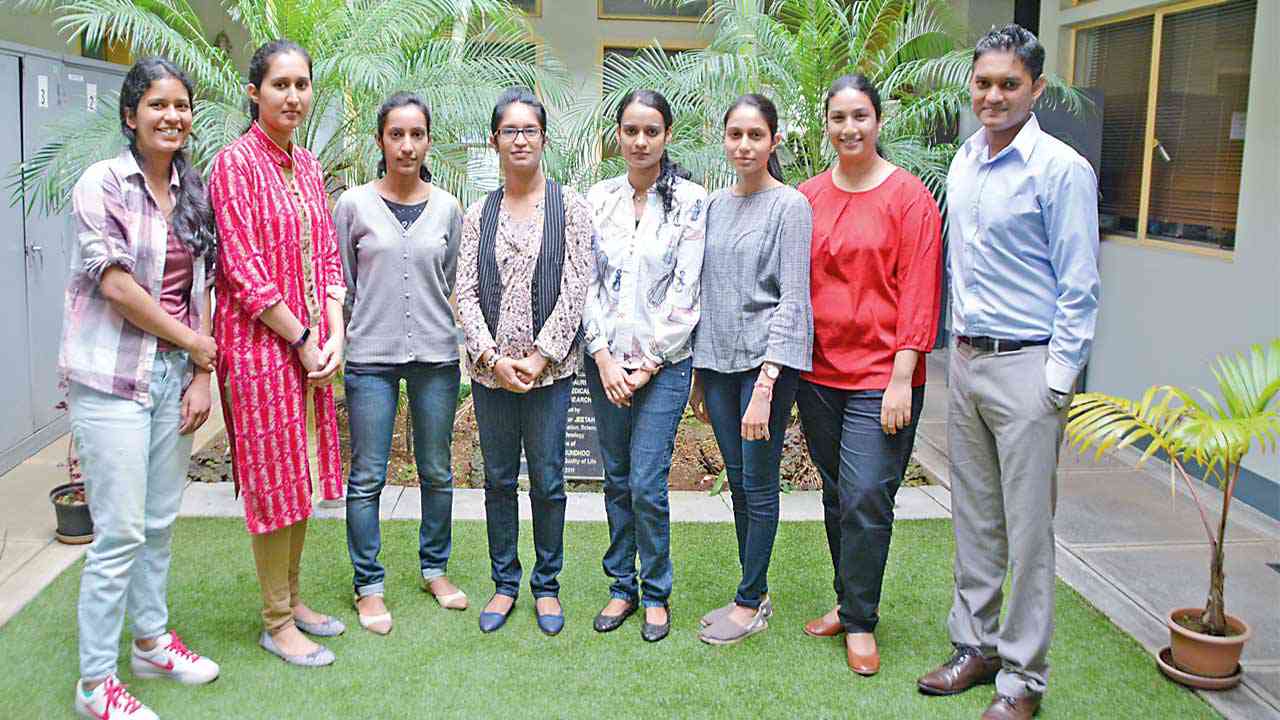
With the advent of technology, a small group of UOM researchers in 2010 set the base for nanotechnology and Nano science in Mauritius. The Centre for Biomedical and Biomaterials Research (CBBR) was officially approved by UoM’s Council in May 2011. This week, we take you to discover this nanotechnology and nanoscience taking place in Mauritius and things that we can rarely hear in our local context.
CBBR was proclaimed Centre of Excellence by the African Network for Drugs and Diagnostics Innovation (ANDI) in Oct 2011 after a rigorous peer-review process. This achievement is considered to be a milestone in the history of scientific research in Mauritius. CBBR is the only CoE in the Indian Ocean region and one of the 32 CoEs of the ANDI network endeavouring to promote health innovation in Africa and in the Indian Ocean Islands.
The Biomaterials, Drug Delivery & Nanaotechnology unit funded under NRC Biomaterials and Drug Delivery Programme is led by Dr Archana Bhaw-Luximon (Associate Prof) in consultation with Prof Dhanjay Jhurry. The aims of this unit is are to undertake research on advanced polymer materials, nano-biomaterials and nano-drug delivery, development of value-added products from indigenous land and marine resources, biopharmaceuticals based on medicinal/endemic plants, and their biological activity and molecular mechanisms of action for the prevention of diabetes, cardiovascular diseases and cancer.. The motto of the Biomaterials, Drug Delivery and Nanotechnology Unit to move forward excellence in research is Rigor, Respect, Responsibility and Resilience.
Dr Archana Bhaw-Luximon explains that in order to achieve a knowledge-based innovation-driven economy and society we need to identify the cornerstones of our national strategy. “Resting on the existing knowledge built over the past decade by its scientists, Nanotechnology has been rightly identified by the Mauritian Government as one of these cornerstones. The Biomaterials, Drug Delivery and Nanotechnology Unit at the Center for Biomedical and Biomaterials Research (CBBR) the spearhead research center of the University of Mauritius has as mission to advance Research and Innovation in that area, continue building human capacity, make available to Industries including SMEs unique analytical facilities and help the country to find its niche in Nanotechnology and Nanoscience.”
She reveals that together with other researchers, it endeavours to steadily bring about an increase in global ranking of the University and improve its research influence both regionally and internationally. “The growth of the Centre is due to its focus on excellence in research and building a strong research infrastructure. Research and Innovation in the Unit is focused on fabrication of scaffolds for skin and bone tissue regeneration, engineering Nano Carriers for anti-cancer, anti-diabetic and anti-TB drugs as well as biomolecules such as artemisinin, value-added materials from land and marine resources such as bagasse & seaweeds for high-end application.”

Functioning of the BDDN Unit
The Unit consists of three Post docs, two MPhil/PhDs and two Research Assistants. Two new PhDs will be recruited soon to work on new challenges in this field and research projects are funded by the Mauritius Research Council. It also provides opportunities for short-term attachment for Young Mauritian scientists working both abroad and locally.
The centre has a strong research infrastructure which includes a Scanning Electron Microscope, a fully equipped Level 2 Bio Lab and other high-tech equipment. Its researchers have received a number of International Recognition such as Dr Nowsheen Goonoo (2015) and Dr AnishaVeeren (2017) selected for Lindau Nobel Laureate Meeting, Germany, Dr Nowsheen Goonoo awarded Georg Forster Research Fellowship from the Alexander von Humboldt Foundation (2016-2017) and Dr Archana Bhaw-Luximon selected to attend both the first and second Commonwealth Science Conferences (2014, 2017).
Nanomedicine and Cancer Nanotherapeutics
Dr Archana Bhaw-Luximon states that nanomedicine is the application of nanotechnology to prevent and treat diseases such as cancer. One such successful example on the market is Nab-Paclitaxel (AbraxaneÒ) used in advanced pancreatic cancer, breast cancer and small lung cancer. “The current trend in cancer chemotherapy is the use of multiple drugs for synergistic actions to improve drug efficacy. The Unit has engineered mixed nanoparticles for synergistic action of multiple anti-cancer drugs tested on pancreatic cancer cell line. It is now looking into the dual loading of anti-diabetics and anti-cancer drugs using smart responsive nanoparticles.”
Regenerative tissue engineering
The Associate Professor explains that the National Health Institute of the USA refers to tissue engineering as the practice of combining scaffolds, cells, and biologically active molecules into functional tissues. “The goal of tissue engineering is to assemble functional constructs that restore, maintain, or improve damaged tissues or whole organs. Artificial skin and cartilage are examples of engineered tissues that have been approved.”
According to Dr Archana Bhaw-Luximon, this field is moving towards the use of scaffold nano fibrous mats with the ability to mimic biomilieu of wound and trauma site for cell growth. “The BDDN Unit has fabricated and tested with skin/bone cells, a range of electrospun polymeric mats. These mats can be made up of cellulose extracted from sugar-cane bagasse, carrageenans/fucoidans from seaweeds, biodegradable polyesters as well as contain bioactive molecules. The Unit is now moving towards 3D hybrid scaffolds and applying computational mechanics to predict scaffold performance.”
Help SMEs and local Industries to launch new products
As highlighted by Dr Archana, nanotechnology is an emerging area and can help SMEs to launch new products in the market. “Nanotechnology is not only biomedical but it has other application like nano coating where nanoparticles are used. Nanocoating can be used for painting products to prevent high temperature or make fabrics for hospital use to prevent infection. We are willing to help SMEs to who are interested to launch nano-based technologies. We want to help Mauritius to achieve the status of a high knowledge based country.”
Break from traditional profession
Another vision of the centre is to promote other career choices for graduates in science, medicine and engineering. “Many graduates have difficulties in finding jobs and some of them are not willing to join the traditional job market, so they can get into research. So this field is another opening for the young graduates. We need trained professionals, so it is an opportunities for them.” Let us also embrace the future technologies.
Upcoming projects
Dr Archana reveals that all their projects have arrived are reaching at the stage of proof of concept. Their next five years will concentrate on biological testing. For the next academic year, at the University of Mauritius, a master programme on Applied Nanotechnology is in preparation will be introduced with the collaboration of with foreign universities. Apart from existing collaborations, amongst the newly developed projects are Duke-National University of Singapore for tissue engineering and Cyclotron Reunion Ocean Indian for nanomedicine.








